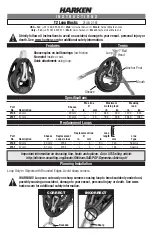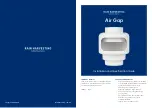
1-4
Brakes -
Lock all steer casters in line and set all caster brakes before transferring patient.
Bed Height -
To minimize the risks of falls or injury, the unit should always be in the lowest practical position
when the patient is unattended. Make sure area under and around bed frame is clear of objects, persons and
parts of body before adjusting height.
Bed Exit Alarm -
Activation of the bed exit alarm is recommended whenever patient is unattended. Be sure
to reactivate the bed exit alarm each time patient returns to unit.
Bed exit alarm is triggered by dramatic weight reduction and may not alarm if patient is only partially
exited from unit.
Ambulatory Patient Entrance and Exit -
Caregiver should always aid patient in entering and exiting the
unit. Lower patient surface completely during assisted patient entrance / exit and patient turning.
Arm Cushions -
If
Kinetic Therapy
patient turning is to be provided, it is recommended that the patient
be secured with the straps on the arm cushions when they are used. Maintain a one-inch clearance
(approximately two fingers’ width) between the end of the arm cushion and the patient’s axilla. Never place
arm cushion snugly against patient’s axilla. Undue pressure on axillary blood vessels and brachial plexus may
result.
Rotation Pack Support -
Do not remove rotation pack supports which must be used to help position
the patient when rotation angles are more than 20° to either side. Rotation pack supports (or body packs)
include the head pack, side support packs and leg abductor pack. Also refer to side rails in the
Risks and
Precautions
section.
Tube and Line Management -
Prior to activating rotation, assess the security of all invasive lines and tubes
to accommodate a full 60° angle of rotation and minimize the risk of binding, disconnecting or dislodging.
Tubes and lines should always have slack for rotation and patient movement.
Fluids -
Avoid spilling fluids on unit controls. If spills do occur, unplug unit, clean fluid from unit wearing
rubber gloves to avoid any possibility of shock. Once fluid is removed, check operation of components in area
of spill.
Fluids remaining on controls can cause corrosion, which may cause components to fail or to operate
erratically, possibly producing hazards for patient and staff.
Oxygen Use -
DANGER
: Risk of explosion if used in the presence of flammable anesthetics. Use of this
product in an oxygen-enriched environment may produce potential of fire hazard. This equipment is not
suitable for use in the presence of a flammable anesthetic mixture with air or with oxygen or nitrous oxide
.
When using half-bed-length-type oxygen administering equipment, ensure that side rails are
outside of oxygen tent and not contained within the oxygen environment. Hand control not
available with this product.
Lock-Outs -
Lock-outs for bed functions and air functions should be used at staff’s discretion to ensure
against unintentional operation of system settings.
Moving Parts -
Powered bed mechanisms can cause serious injury. Keep all equipment, tubes and lines,
loose clothing, hair and parts of body away from moving parts and pinch points.













































